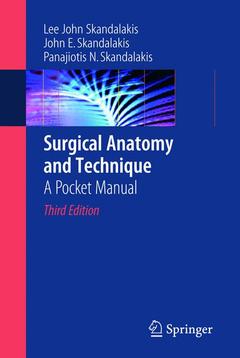Description
Surgical anatomy & technique: a pocket manual (3rd Ed.)
Author: SKANDALAKIS L.J.
Language: English
Subjects for Surgical anatomy & technique: a pocket manual:
Approximative price 45.31 €
Subject to availability at the publisher.
Add to cart
Publication date: 03-2009
692 p. · 13.5x20.5 cm · Paperback
692 p. · 13.5x20.5 cm · Paperback
Description
/li>Contents
/li>Comment
/li>
Generations of residents and general surgeons have relied upon and worn out their copies of Surgical Anatomy and Technique: A Pocket Manual. Thoroughly revised and with dozens of new illustrations, the third edition continues the tradition of providing a concise, accessible, and generously illustrated memory refresher for both novice and experienced clinicians. The authors have included techniques to keep the content fresh, relevant, and practice-based. Among the new topics are abdominal aortic aneurysm, femoropopliteal bypass, carotid endarterectomy, hysterectomy and oophorectomy. All the existing chapters have been updated to reflect current surgical approaches and instrumentation. Surgical Anatomy and Technique provides the gold standard in correlating clear, practical anatomy with the correct technique in the pursuit of the best possible patient outcomes. This handy pocket manual remains a "must have" for every resident and general surgeon.
Ski. scal. and nail.- Neck.- Breast.- Abdominal wall and hernias.- Diaphragm.- Esophagus.- Stomach.- Duodenum.- Pancreas.- Small intestine.- Appendix.- Colon and anorectum.- Liver.- Extrahepatic biliary tract.- Spleen.- Adrenal glands.- Vascular system.- Uteru. tube. and ovaries.- Carpal tunnel.- Microsurgical procedures
From the reviews of the third edition:'A longstanding key resource for residents and general surgeons, in user-friendly pocket-manual format, this latest edition is thoroughly revised, with many new illustrations. The authors ... keep content relevant, fresh and practice-based, new topics include carotid endarterectomy, hysterectomy and oophorectomy. Existing chapters have been updated to reflect current surgical approaches.' (Times Higher Education, February, 2010)
© 2024 LAVOISIER S.A.S.
These books may interest you

Carotid Artery Stenting: The Basics 210.99 €



